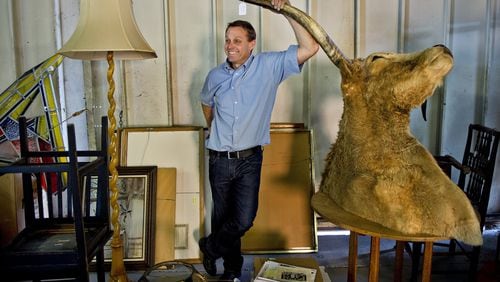SACRAMENTO, Calif. — It’s a “Roadshow” experience without leaving town.
Since he started offering free evaluations at his Sacramento auction house, antiques expert Brian Witherell has seen all sorts of items; a few worth big bucks, but most valued more sentimentally than monetarily.
But that chance of discovery — both for the collector and the expert — keep people lining up in hopes of learning more about their personal treasures. As fans of “Antiques Roadshow” know, that’s part of the fun.
As a second-generation “Antiques Roadshow” appraiser, Witherell has evaluated thousands of items, big and small. He travels nationwide as an expert on the long-running PBS series as well as running his family’s Sacramento auction house.
This fall, he decided to bring that “Roadshow” experience — without the long lines and ticket lottery — to his Sacramento headquarters with a weekly Consignment Day every Tuesday. He meets personally with the folks who bring in their items and enjoys hearing the stories behind these finds. It’s also a way to unearth local prospects for future auctions.
Each year, his auction house hosts several themed auctions devoted to such categories as toys, Gold Rush antiques, and western arts and crafts. Coming soon is Witherell’s annual Holiday Gifts auction.
Witherell shared his insights on collecting, Sacramento style:
Q: Since you started these free evaluations, what are you seeing most? Any trends in what people are bringing in? Or is it all over the board?
A: The walk-in material we are seeing on our weekly consignment days is consistent with the material typically found in the Sacramento area: Native American, antique firearms and militaria, jewelry, Asian and paintings, as well as decorative items of little value. What is interesting to us, however, is how many people are looking for this service.
Q: Have there been any big discoveries that were brought in, such as the kind of items usually reserved for the "Roadshow" finale? What about "only in Sacramento" finds?
A: Yes. Our Sacramento "Roadshow"-worthy discovery was an early work by (artist) Wayne Thiebaud. It predates his pop-art style but is unique because it was given as a gift to another Sacramento artist, Fred Ball. It was consigned by a relative of the collector whose note indicated it was purchased in the 1970s for $200. We are estimating its auction value at $5,000 to $10,000.
Q: What's the antique and collectibles market been like the last few years? The value of a lot of items went down during the recession. What's bounced back? What hasn't recovered?
A: The shift has been profound over the last year. It's almost reversed itself in that what once was desirable isn't and what wasn't is. In part because of the recession, but in my opinion it's more of a generational shift in taste. Traditional, 100-year-old antiques have in most cases been a slow recovery while postwar and contemporary fine and decorative arts are on the ascent.
Q: What's hot right now?
A: While there are exceptions in every category, the material that is "hot" is the same we are seeking: small shippable objects of value in high-demand collecting categories and with international interest, such as jewelry, paintings, militaria, coins and luxury goods.
Q: What's not hot?
A: Antiques that require maintenance and make life inefficient are not hot. Who wants to polish silver or hand wash china?
Q: Is "brown furniture" — mahogany and oak, 19th century or pre-WWII — worth holding on to? Will it ever make a comeback?
A: The trend toward contemporary living has made most "brown furniture" forms obsolete. Built-ins and great rooms eliminated the need for forms like armoires (or big cabinets) and, having lived both ways, I can say with certainty postwar sofas are far more comfortable than prewar sofas. Holding onto it for investment purposes requires you to believe this trend will change.
Q: If people are rummaging through grandma's attic or closets, what are a few kinds of items they should be on the lookout for? What about some items that they may not have thought about as having value?
A: Un-obvious, objects of value are hard to identify because they are most often uncommon. It's what gives us (appraisers) job security. However, items at the greatest risk of being discarded in my mind are from the 1970s or '80s. For example, an early Apple computer could be worth $100,000 or more and clothing like Hawaiian shirts and baseball caps can be surprisingly valuable.
Q: Here's one that puzzles a lot of folks: Is there an official definition to the term "vintage"? It's used so much with collectibles — and some not that old.
A: We don't apply that word to our cataloging entries, but my thought is "no." The industry is desperately trying to rebrand itself and this seems to be the go-to replacement word for "antique."
Q: Any tips for collectors and/or treasure hunters?
A: I think lives are enhanced by collecting and living with interesting objects. I wish more people understood how rewarding it can be. There are many categories and areas of interest for all income levels. Find one of interest, buy what you like and don't be afraid to fail.






